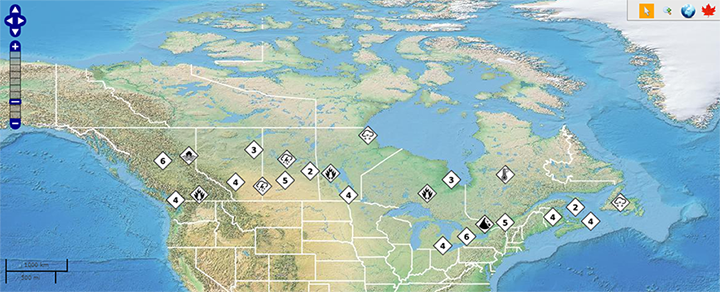Tornadoes
Tornadoes are unmistakable rotating columns of high-velocity wind that brings devastation to anything in their path. They are difficult to predict. Sometimes they move quickly and can leave a wide swath of destruction. At other times the tornado is small, touching down sporadically and leaving a haphazard path of damage. In either case they can uproot trees, flip cars and demolish houses. Canada probably gets more tornadoes than any other country with the exception of the United States. Southwestern Ontario and parts of the southern Prairies are most often struck.
Most tornadoes occur in June and July and although their season extends from April to September, they can occur at any time of year. They frequently develop in mid-afternoon to early evening.
Environment Canada warns the public about tornadoes but because they are hard to predict and can move at up to 70 km/hour, a tornado can strike without warning. Typically, a tornado is preceded by a severe thunderstorm and is associated with black skies, strong winds, lightning, thunder and heavy rain or hail. Sometimes the sky will turn an unusual green colour and the wind will sound like a freight train.
There is protection from a tornado. Most deaths and injury occur when buildings collapse or when people are struck by flying debris, especially glass. So it is best to get quickly into a well-supported basement area. If this is not possible, a room with strong walls will do (such as a bathroom or under a stairwell). If you are outside, crouch or lie down in a ditch. Houses collapse most often because of improper anchoring of walls to foundations and roofs to walls. Mobile homes and cottages are the most susceptible to damage, because they are generally not anchored and are constructed to lower standards.
The worst Canadian tornado, by death toll, occurred at Regina on June 30, 1912. When an F-4 cut a five-block-wide swath through the city -- 28 people died, 200 were injured and 2,500 left homeless. About 500 buildings were destroyed. Other devastating Canadian tornadoes include the Edmonton tornado of July 31, 1987, which killed 27 people and injured 300.
Because most tornadoes spin counter-clockwise, moving along an east to northeast path, the winds on the south side of the tornado are stronger. Vortices inside a main tornado can follow a looping trail, rather than a straight line. They do not always stay on the ground but skip along destroying one house and leaving neighbours untouched.
Tornadoes are graded for intensity on the "Fujita scale'' (named after the noted tornado research scientist, Ted Fujita), from F-0 to F-5. Canada has never had an F-5 tornado. Of Canadian tornadoes, 45 percent are F-0, 29 percent are F-1, 21 percent are F-2, four percent are F-3 and just one percent are F-4. An average F-0 tornado track is about 40 metres wide and 1.7 kilometres long. An average F-4 track is about 400 metres wide and 36 kilometres long.
| F-scale | Wind speed (km/h) | Damage |
|---|---|---|
| F-0 | 64 - 116 | Light |
| F-1 | 117 - 180 | Moderate |
| F-2 | 181 - 253 | Considerable |
| F-3 | 254 - 331 | Severe |
| F-4 | 332 - 418 | Devastating |
| F-5 | 419 - 512 | Massive devastation |
For further information on specific events, see the Canadian Disaster Database.
To learn more about how individuals can get better prepared to cope with natural hazards, check out the information available from GetPrepared.
Emergency Management News Releases
Emergency Management Publications and Reports
- Government of Canada Response to the Public Order Emergency Commission Recommendations
- Advancing the Federal-Provincial-Territorial Emergency Management Strategy: Areas for Action
- Evaluation of the Initiatives to Address Post-Traumatic Stress Injuries (PTSI) Evaluation Report
- Summary of the Evaluation of the Initiatives to Address Post-Traumatic Stress Injuries (PTSI) Among Public Safety Officers
- The First Public Report of the National Risk Profile
- Date modified:
